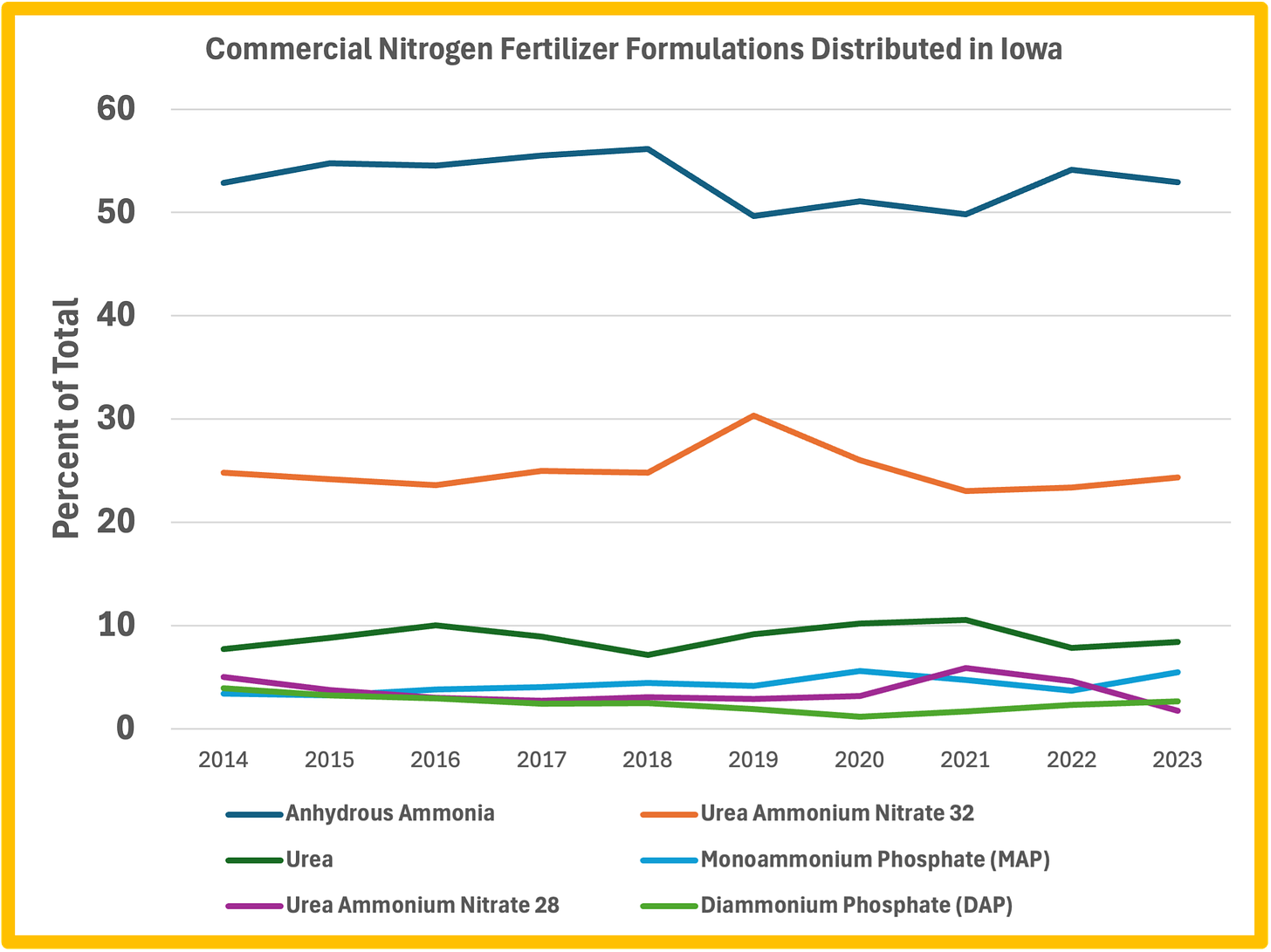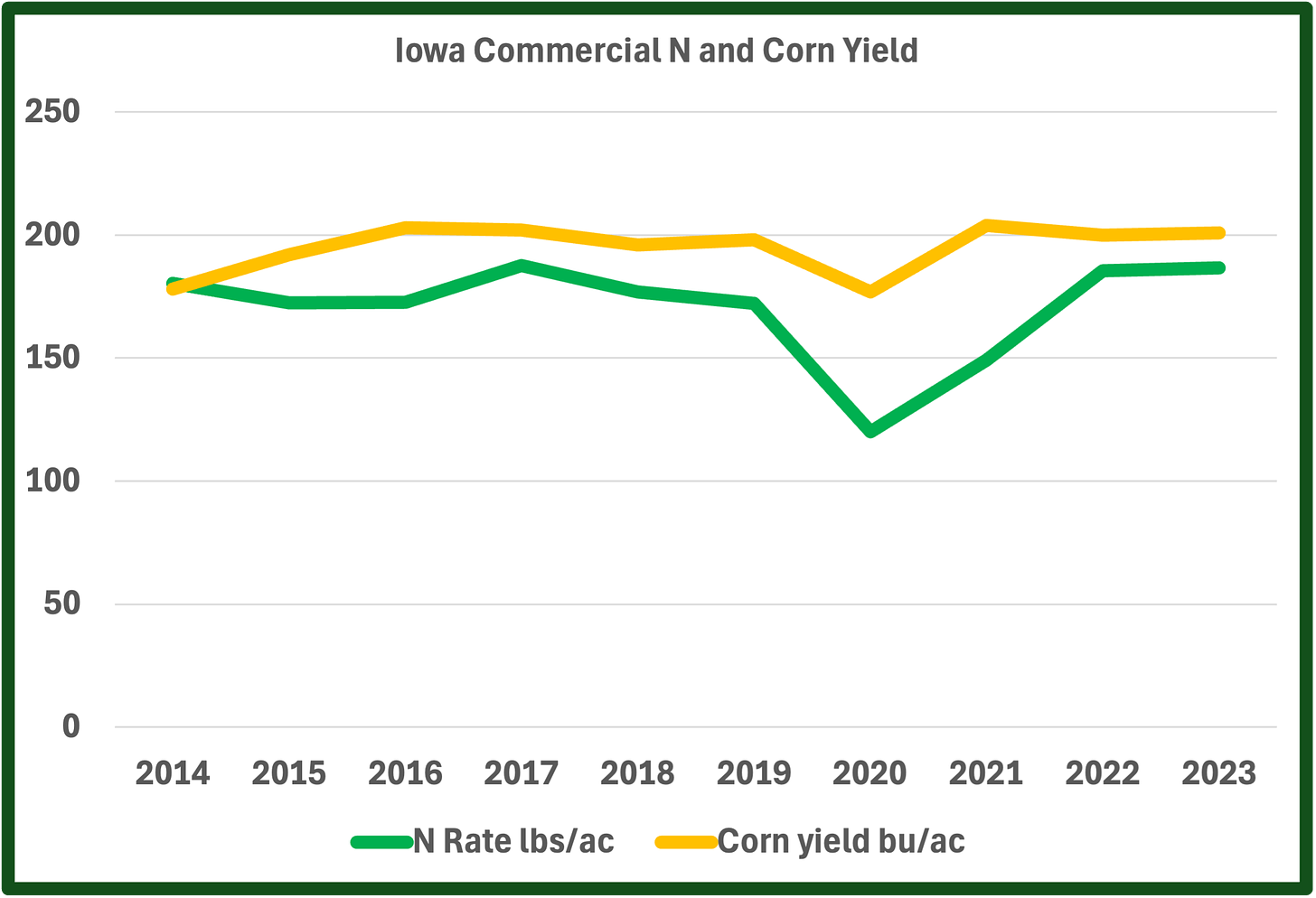Cedar Rapids Gazette columnist Todd Dorman recently told me some farmers are insisting that there has been an exciting acceleration toward lower nitrogen fertilizer application rates (rate deceleration, perhaps?) onto Iowa corn. Because nitrogen (N) lost from cropped fields ends up in our water as nitrate and in the atmosphere as nitrous oxide (300 times more greenhouse gas potential than carbon dioxide), this deceleration would be, as the cool kids say, ‘big, if true.’
Since the Iowa Department of Agriculture and Land Stewardship (IDALS), led by Minister of Propaganda Mike Naig, keeps track of nitrogen fertilizer distribution, I thought I might as well go ahead and check the veracity of these declarations of deceleration.
The Fertilizers
IDALS currently tracks the distribution of 23 separate formulations that contain various percentages of nitrogen and sometimes other macro and micronutrients. I converted the distributed product tonnage reported by IDALS to the actual weight of nitrogen in the product, based on the N percentage. Eight of these 23 comprise 99% of the nitrogen fertilizer sold over the past 10 years (2014-2023):
Table 1: percentage of all nitrogen distributed in commercial formulations in Iowa, 2014-2023
A year in this circumstance is a crop year, which is July 1 to June 30 the following year, because many farmers fertilize in the fall for the following year’s corn crop. For example, the 2023 crop year ran from July 1, 2022 to June 30, 2023. In an average year, about 2.2 billion pounds of nitrogen is distributed throughout Iowa in the various products and sold at some 1000-odd retailers. The big wholesalers include CF Industries, Mosaic, Nutrien, and your friends at Koch Industries, who just purchased the big fertilizer plant at Weaver, Iowa that you helped build.
The product mix hasn’t changed much over the past 10 years (graph below). This is curious because there’s a lot of crowing about side-dressing nitrogen these days: applying a liquid formulation like UAN 28 or 32 after the crop has emerged, i.e., ‘spooning it on’ in farmer parlance to imply the nitrogen is being dripped onto the baby corn like it was a newly hatched bird, beak agape awaiting the tiniest morsel of sustenance from its tirelessly hardworking parent. But as you can see, the graph doesn’t show much movement toward those products.
Are N Rates Going Down?
No, they are not. In fact, were it not for some volatility in price and availability around the COVID pandemic (2020-21), late spring snows preventing pre-plant application at that time, and very low corn prices in 2020 (which can reduce enthusiasm for commercial fertilizer), not much has changed at all in the last ten years. Since the area of corn planted is the main driver of how much nitrogen fertilizer is applied in Iowa, the graph below illustrates the total amount of commercial N fertilizer distributed divided by the number of Iowa corn acres over the past 10 crop years for which data is available.
Also shown in the graph below is Iowa corn yield (bushels per acre). Yields were lowest in 2020 because crop geneticists haven’t yet solved Derecho-force wind. But you can see the very next year, 2021, crop yields were highest in the 10-year period, even though application of commercial nitrogen was 2nd-lowest of the 10 years, and this following the lowest year of N fertilizer distribution.
It raises some questions, doesn’t it?
Let’s say you’re an individual farmer cropping 1000 corn acres whose N and corn yield numbers match the state average. In 2021 you spring applied 149,000 pounds of anhydrous nitrogen at a total cost of around $67,000. You then harvested 204,000 bushels of corn that had a value of $1.16 million if you sold it all at the end of October. In 2023 you applied 187,000 pounds of nitrogen at an approximate cost of $93,500 and harvested 201,000 bushels of corn worth $933,000 if sold at harvest. To summarize, 2021, $67k for N, $1.16M for corn. Then, 2023, $93.5k for N, $933k for corn. Applying that extra 38 pounds per acre in 2023 probably cost you at least $20,000, but in the grand scheme of a million-dollar farm operation, meh. Harold might have to hold off on that new RV for a year.
Meh, that is, as long as the public shoulders the burden of the pollution.
Rates Compared to Recommended
Iowa State has this cool tool called the N rate calculator. You plug in your price of nitrogen and the expected price of corn and it recommends a nitrogen rate. Let’s say you’re the farmer above and you could have predicted the price at the elevator of $5.68/bushel in 2021. Your recommended rate using the calculator is 154 lbs/acre if you grew your corn following soybeans, and 199 lbs/acre if it was corn following corn.
In 2023, with nitrogen around $0.50/lb and corn ultimately at $4.64, the calculator says 145 lbs/ac following soybean and 187 lbs/ac following corn.
Now for the ugly part
Since about 15% of Iowa crop acres are planted to corn continuously while about 85% of the acres are in rotation with soybeans, the overall ISU recommended statewide average for ’23 pencils out to around 155 lbs per acre, which is about 30 pounds per acre below the actual amount distributed. That sounds bad, and it is, but believe me when I tell you this: if you want cleaner river water, safer drinking water, and nicer beaches you could probably live with that, if that were the end of the story.
Alas, you may have noticed I haven’t mentioned anything about livestock manure. The 25 million hogs, 4 million cattle and 60 million chickens that reside in Iowa on any given day excrete upwards of 1.5 billion pounds of nitrogen every year. It’s got to go somewhere. So yes, we’ve already satisfied corn needs at the statewide level with commercial fertilizer without even considering the animal manures in the state that produces more of it than any other.
What this all tells us is that we are not regulating manure nutrients in any meaningful way. Our laws endorse an over-application of nutrients and allow new CAFO construction with no consideration of existing animal populations. The manure management plans required by the law are shit, the farmers aren’t following them, and Iowa DNR isn’t regulating or enforcing them. At least in aggregate, farmers are not taking full credit for manure and since it is usually free they’re viewing it as (chocolate) frosting on any already calorie-rich nutrient cake. And that’s the way agribusiness wants it, because if the manure was all taken seriously, that would reduce the lucrative sales of commercial fertilizer. I’ve known this in an objective way for several years now; so have many others in the industry, government and academia that don’t want to talk about it. It’s despicable that so many of our institutions all but sanctify this defilement of the state’s water resources that belong to you—not the farmers, not agribusiness, not politicians—through their unwillingness to speak about this in public.
Many of our politicians of both parties are also at least vaguely aware of this situation but many are also farmers (especially Rs) and many in both parties are funded by agribusiness and the livestock industry. Who some of these latter folks are may surprise you. I urge you to ask them about this.
Resources
https://www.iowafarmbureau.com/Article/Hog-Market-Update-December-2022
https://quickstats.nass.usda.gov/results/36850982-61C9-3584-87DA-4529ABBA7512
https://www.iowapork.org/filesimages/Documents/Full_Iowa-Pork-Industry-Report.pdf
https://www.southeastiowaunion.com/news/hog-inventory-numbers-continue-to-climb/
https://www.legis.iowa.gov/docs/publications/IR/1048437.pdf
https://farmdocdaily.illinois.edu/2022/07/nitrogen-fertilizer-outlook-for-2023-decisions.html
https://www.macrotrends.net/2532/corn-prices-historical-chart-data#google_vignette
https://www.agriculturedive.com/news/koch-oci-fertilizer-plant-sale-wever-iowa/725901/







Seven years ago, it became clear to me that limiting phosphorus application rate as prescribed by ISU publication pm1688 would completely solve animal manure pollution. To mitigate manure application cost simply apply manure at the nitrogen rate on a three-to-four-year rotation basis with soy beans planted in the rotation.
The latest craze to reduce nitrogen application rate is another tax payer subsidized give away. Try using less nitrogen and we will pay you $35 per acre if your yield drops below the 10-year average. Give us more money and we will stop polluting. We will voluntarily take your money but don't tell us what to do.
My final solution: Stop all agriculture and related subsidies.
All of that beautiful black dirt in Iowa being used to feed cattle and cars.
Meanwhile, Iowans are importing 90% of their food!